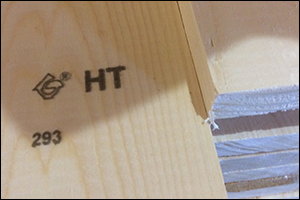You would never drop an envelope in the mailbox without the proper postage. Or expect your vehicle to pass inspection without a current registration sticker. But you might not know that a shipping will not clear customs on arrival at its destination country unless it sports a specific type of stamp on the side panel.
In 2002, the International Plant Protection Convention (IPPC) adopted International Standard for Phytosanitary Measures No. 15 (ISPM-15) to help prevent the spread of non-native invasive pests through global trade. Before allowing any form of wood packaging material (including wooden pallets, crates, or skids) to enter their country, customs officials will look for an IPPC ISPM-15 certification stamp.
The agreement requires that all wooden crates and wood packaging materials crossing international borders must be constructed exclusively of heat-treated lumber. Letting an export shipment into the country without the appropriate heat treatment stamp can introduce insects which could put agricultural crops, forests, and other plant life at serious risk.
What Happens if the IPPC ISPM-15 Stamp is Not Clearly Visible on a Wood Crate?
If an ISPM-15 stamp is not clearly visible on the exterior of the crate, customs officials have no choice but to halt your shipment, which will then be:
1) Methyl Bromide Fumigated. To protect their nation from stowaway pests, customs officials are likely to fumigate any crate that arrives at their borders without proper certification. The fact that your shipment could suffer negative effects if fogged or sprayed with insecticide is not their top priority.
2) Uncrated and re-packaged. If they can’t verify that the crate is constructed exclusively of heat treated wood, customs officials might unpack your product and re-crate it using local lumber. Of course, there’s no guarantee that they will follow the same rigorous packaging protocols as your original export crating company, so there is a serious risk that your product could be damaged in transit.
3) Seized. Depending on the manpower and resources available at the customs checkpoint, customs officials might just deny the shipment entry to the country. The immediate result is a missed shipping deadline; longer-term, you can expect to spend time, energy, and financial resources sorting the necessary details to get your package released for import.
Have the Proper ISPM-15 Stamp, Will Travel
But shipping crates tattooed with an IPPC ISPM-15 stamp can sail through customs without risking a spontaneous fumigation or de-crating. So it’s worth double-checking the pedigree of any crates you plan to ship outside your borders. To pass inspection at a customs checkpoint, wooden crates must be:
1) Constructed exclusively of heat-treated lumber.
At the sawmill, after an enormous log is cut and planed into lengths of lumber, it might then undergo additional treatments to enhance its usability or durability. For example, lumber might be “kiln-dried” to remove moisture and prevent warping.
To be suitable for use in crates destined for international travel, wood packaging materials must be “heat-treated” to kill off any insects or other pests (like an emerald ash borer or a pinewood nematode) that might be hiding in the lumber. To prevent the migration of invasive species, the core of each individual piece of lumber must be heated to a minimum of 56 degrees C (133 degrees F) for at least 30 minutes. When that milestone is achieved, the lumber gets an HT stamp.
Here are several examples what the stamp for heat-treated lumber looks like. Pictures are from our CDC Packaging workshop.



2) All wooden crates for international export must be fabricated by an IPPC ISPM-15 certified packaging manufacturer.
One common misconception is that any organization with a woodshop and some basic carpentry skills can purchase heat-treated lumber and make a wood crate, skid or pallet for international shipments. But in order to pass through customs each wood crate must be stamped “IPPC ISPM-15 certified” which signifies that the crate was constructed exclusively of heat-treated lumber at a certified facility .
To earn a certification and be issued a stamp, wood crate manufacturers must pass routine inspections by an organization such as the Northeastern Lumber Manufacturers Association (NELMA), which polices wood packaging material producers throughout New England. Each certified business is issued a customized stamp that they apply to every export crate they make.
Here is the ISPM-15 certification stamp that identifies each one of CDC Packaging’s wooden export crates as ready for international shipping:
CDC Packaging is an ISPM-15 Certified Packaging Manufacturer
Don’t get caught unprepared at a customs checkpoint! Make sure to package your exports in crates that are certified to IPPC ISPM-15 standards. Contact us today to arrange your next international shipment.

